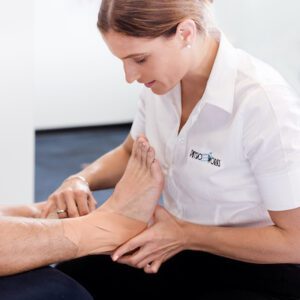Prehabilitation
Article by Zoe Russell
Prehabilitation: Your Pathway to Injury-Free Sports
Introduction to Prehabilitation
In the dynamic world of sports, physiotherapists have pioneered an innovative approach to injury prevention known as “prehabilitation.” This proactive strategy involves a preventive injury risk assessment and training, aiming to address potential issues before they manifest.
The Three Phases of Prehabilitation
Prehabilitation is grounded in a three-phase process:
- Posture and Movement Analysis: This involves assessing an uninjured athlete’s posture, joint alignment, flexibility, muscle control, biomechanics, core stability, and movement patterns.
- Sport-Specific Risks Assessment: Understanding the inherent risks associated with the sport itself is crucial.
- Player Position Consideration: Tailoring strategies to the player’s specific role within the sport.
By following these steps, a sports physiotherapist can accurately predict injury risks and develop tailored training programs to mitigate common overuse and sports injuries.
Explore the Effectiveness of Prehabilitation in Sports
The Best Exercises for Prehabilitation
The essence of prehabilitation lies in its sport and athlete specificity. It emphasises the predominant muscle movement patterns unique to the athlete’s position in their sport. For example, the physical demands on a goalkeeper differ significantly from those on a field player.
The Benefits of Prehabilitation
Engaging in prehabilitation offers numerous benefits:
- Achieving balanced static and dynamic posture
- Correcting muscle length imbalances and joint misalignments
- Normalising core stability across various regions
- Enhancing muscle endurance, strength, and power
- Improving movement pattern efficiency
- Boosting proprioception – your body’s ability to sense joint positioning
Each sport, and positions within these sports, such as a defender or attacker, requires a bespoke prehabilitation approach.
Seeking Professional Advice
For individuals, teams, or clubs interested in sports screening or prehabilitation programs, consulting with a sports physiotherapist is invaluable. These programs lead to enhanced performance and reduced injury rates. Services like club, school, team, and individual pre-injury screening, alongside injury risk profiling and prevention strategies, are available at PhysioWorks.
Conclusion: Empowering Athletes with Prehabilitation
Prehabilitation represents a significant shift in sports medicine, moving from reactive to proactive injury management. By incorporating these strategies, athletes can enjoy a safer, more effective sporting experience.
What to Do Next?
If prehabilitation interests you, consider contacting a qualified sports physiotherapist. They can offer personalised advice and programs tailored to your specific needs and sport. For more information and related articles, visit PhysioWorks.
Article by Zoe Russell
Sports Physiotherapy FAQs


Sports Physiotherapy is the specialised branch of physiotherapy which deals with injuries and issues related to spokespeople. Practitioners with additional formal training within Australia are Sports & Exercise Physiotherapists.
What is Sports Physiotherapy?
Sports injuries do differ from common everyday injuries. Athletes usually require high-level performance and demands placed upon their bodies, which stresses their muscles, joints and bones to the limit. Sports physiotherapists help athletes recover from sporting injuries and provide education and resources to prevent problems. Each sports physiotherapist usually has sport-specific knowledge that addresses acute, chronic and overuse injuries. Their services are generally available to sportsmen and women of all ages engaged in sports at any level of competition.
Members of Sports Physiotherapy Australia (SPA) have experience and knowledge of the latest evidence-based practice, professional assessment and diagnosis of sports injuries, and effective hands-on management techniques and exercise protocols to assist recovery and prevent future damage. SPA members have access to the most recent advances in sports physiotherapy. You'll be pleased to know that most PhysioWorks physiotherapists and massage therapists are particularly interested in sports injury management.
General Sports Physio FAQs
- Sports Physiotherapy
- Acute Sports Injury Clinics
- Sports Physiotherapy Treatment
- Youth Sports Injuries
Injury Management
- Sports Injury? What to do? When?
- When Can You Back to Sport?
- Sports-Related Injuries
- Knee Sports Injuries
- Sports Health Conditions
Sports Massage
Sports Insurance
Related Articles
- Sports Injury Management: This article provides a comprehensive look at how sports injuries are managed, including prevention strategies and treatment options.
- Soft Tissue Injury Healing: Readers can learn about the healing process for soft tissue injuries, including practical advice for each phase of recovery.
- Prehabilitation: Key to Injury-Free Sports Performance: Offers insights into how athletes can prevent injuries before they occur, focusing on strengthening and conditioning practices.
- Athletics Injuries - Comprehensive Physio Guide: A detailed guide on common injuries in athletics and how to treat and prevent them, making it a valuable resource for athletes of all levels.
- Acute Sports Injury Clinic: Highlights the services offered by sports injury clinics, including fast-track assessments and treatments for acute sports injuries.
- Effective Management of Kids Sports Injuries: This guide focuses on the unique aspects of managing sports injuries in children, offering parents and coaches valuable advice on care and prevention.




